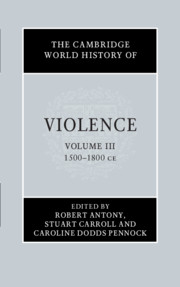Book contents
- The Cambridge World History of Violence
- The Cambridge World History of Violence
- The Cambridge World History of Violence
- Copyright page
- Contents
- Figures
- Maps
- Contributors to Volume iii
- Introduction to Volume iii
- Part I Empire, Race and Ethnicity
- 1 Terror, Horror and the British Atlantic Slave Trade in the Eighteenth Century
- 2 Violence, Slavery and Race in Early English and French America
- 3 Race and Violence in Portuguese America
- 4 Violence and Religion in the Ottoman Empire
- 5 Human Sacrifice, Ritualised Violence and the Colonial Encounter in the Americas
- Part II Cultures of War and Violence
- Part III Intimate and Gendered Violence
- Part IV The State, Punishment and Justice
- Part V Popular Protest and Resistance
- Part VI Religious and Sacred Violence
- Part VII Representations and Constructions of Violence
- Index
- References
2 - Violence, Slavery and Race in Early English and French America
from Part I - Empire, Race and Ethnicity
Published online by Cambridge University Press: 13 March 2020
- The Cambridge World History of Violence
- The Cambridge World History of Violence
- The Cambridge World History of Violence
- Copyright page
- Contents
- Figures
- Maps
- Contributors to Volume iii
- Introduction to Volume iii
- Part I Empire, Race and Ethnicity
- 1 Terror, Horror and the British Atlantic Slave Trade in the Eighteenth Century
- 2 Violence, Slavery and Race in Early English and French America
- 3 Race and Violence in Portuguese America
- 4 Violence and Religion in the Ottoman Empire
- 5 Human Sacrifice, Ritualised Violence and the Colonial Encounter in the Americas
- Part II Cultures of War and Violence
- Part III Intimate and Gendered Violence
- Part IV The State, Punishment and Justice
- Part V Popular Protest and Resistance
- Part VI Religious and Sacred Violence
- Part VII Representations and Constructions of Violence
- Index
- References
Summary
Violence was intrinsic to chattel slavery in the New World, and within slave societies in particular. This chapter analyses the level and forms taken by physical violence, especially corporal punishments meted out to enslaved men and women of African descent in early English and French North American and the Caribbean colonies. Violence was a daily reality within every economic unit relying on slave labour, although the intensity of it varied in time and space. The main reason why slaveholders used physical violence was to constrain their enslaved labourers to work and to accept their conditions. Violence against slaves involved masters as well as non-slaveholders and the public authorities. The pervasive and extreme character of violence in slave societies fuelled a debate on the need to regulate it. All social actors acknowledged its prevalence while describing contrasted regimes of violence and ascribing different meanings to the various forms taken by chastisements. Descriptions of violence create two opposite impressions: violence against slaves remained arbitrary, but at the same time it tended to become normalised. The slave system also sparked violent reactions from enslaved men and women.
Keywords
- Type
- Chapter
- Information
- The Cambridge World History of Violence , pp. 36 - 54Publisher: Cambridge University PressPrint publication year: 2020
References
Bibliographic Essay
- 1
- Cited by

